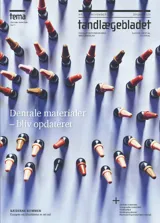Dentale restaureringsmaterialer: Biologiske egenskaber og deres kliniske konsekvenser
Artiklen giver kliniske råd om, hvordan risikoen for bivirkningsreaktioner kan minimeres, samt om, hvordan reaktioner mod tandrestaureringsmaterialer rapporteres.
Tandrestaureringsmaterialer indeholder en mængde forskellige stoffer med ulige biologiske egenskaber. I mundhulen udsættes materialerne for både mekaniske, kemiske, mikrobielle og enzymatiske påvirkninger, og substanser kan frigives fra materialerne. Frigivne substanser kan medføre biologiske effekter i mundslimhinden, eller de kan absorberes og distribueres systemisk og give generelle reaktioner.
I artiklen diskuteres biologiske mekanismer, som kan have betydning for frigivelse af stoffer fra polymerbaserede tandrestaureringsmaterialer, samt de biologiske konsekvenser på celleniveau. Endvidere diskuteres mekanismer for mulige kliniske konsekvenser af eksponering for frigivne stoffer med fokus på overfølsomhed, allergi og toksicitet.
Patienter med reaktioner, som antages at være relaterede til tandmaterialer, bør gennemgå en systematisk udredning. Allergisk kontaktmucositis kan fx forekomme hos patienter med allergi overfor guld, som samtidig har restaureringer, der indeholder guld. Ved kontaktallergiske læsioner i mundslimhinden, fx lichenoid kontaktlæsion, er det indiceret at udskifte det materiale, som patienten reagerer på.
Artiklen giver kliniske råd om, hvordan risikoen for bivirkningsreaktioner kan minimeres, samt om, hvordan reaktioner mod tandrestaureringsmaterialer rapporteres.
Dental restorative materials: Biological properties and their clinical implications
Dental restorative materials contain a large number of substances with different biological properties. In the oral cavity restorations are exposed to mechanical, chemical, microbial, and enzymatic influence, and consequently some of the substances can be released. Released substances can potentially cause biological effects in the oral mucosa, or be absorbed and distributed systemically and cause general reactions. In the present article biological mechanisms which may have importance for the release of substances from polymer based restorative materials, and the biological implications on the cellular level, are discussed. In addition, different mechanisms for clinical implications of the exposure to the released substances are discussed with a focus on hypersensitivity, allergy and toxicity. Patients with reactions allegedly related to dental materials should be examined systematically. Allergic contact mucositis may appear in patients with allergy to gold and simultaneous exposure to dental gold alloys. Patients with contact allergic lesions in the oral mucosa (e.g. lichenoid contact lesions) should have the material causing the reaction replaced. Clinical advice regarding how the risk for adverse reactions to dental materials can be minimized is provided as well as recommendations regarding reporting of adverse reactions to dental materials.


